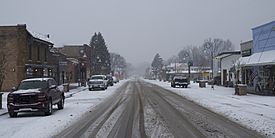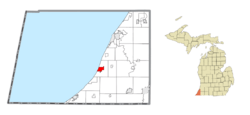Bridgman, Michigan facts for kids
Quick facts for kids
Bridgman, Michigan
|
||
|---|---|---|

Downtown Bridgman along Lake Street
|
||
|
||

Location within Berrien County
|
||
| Country | United States | |
| State | Michigan | |
| County | Berrien | |
| Government | ||
| • Type | City council | |
| Area | ||
| • Total | 2.92 sq mi (7.57 km2) | |
| • Land | 2.89 sq mi (7.49 km2) | |
| • Water | 0.03 sq mi (0.08 km2) | |
| Elevation | 679 ft (207 m) | |
| Population
(2020)
|
||
| • Total | 2,096 | |
| • Density | 724.51/sq mi (279.76/km2) | |
| Time zone | UTC-5 (Eastern (EST)) | |
| • Summer (DST) | UTC-4 (EDT) | |
| ZIP code(s) |
49106
|
|
| Area code(s) | 269 | |
| FIPS code | 26-10580 | |
| GNIS feature ID | 0621967 | |
Bridgman is a city in Berrien County in the U.S. state of Michigan. The population was 2,096 at the time of the 2020 census.
History
There was a place in this area known as Plummer's Pier. In 1856 lumbermen founded Charlotteville in this area.
Bridgman itself begins with the village of that name platted by George C. Bridgman in 1870. It was centered on a railroad station opened that year.
The Bridgman post office, with ZIP code 49106 opened with the name "Laketon" on November 11, 1862. The name changed to Bridgman on April 9, 1874. Bridgman later expanded by annexing the area that had previously been Charlotteville. The town is famous for being the location of the 1922 Bridgman Convention, a clandestine communist planning meeting in 1922 that was broken up by Federal Bureau of Investigation agents and local authorities.
Geography
According to the United States Census Bureau, the city has a total area of 2.93 square miles (7.59 km2), of which 2.90 square miles (7.51 km2) is land and 0.03 square miles (0.08 km2) is water.
Demographics
| Historical population | |||
|---|---|---|---|
| Census | Pop. | %± | |
| 1880 | 194 | — | |
| 1930 | 848 | — | |
| 1940 | 774 | −8.7% | |
| 1950 | 977 | 26.2% | |
| 1960 | 1,454 | 48.8% | |
| 1970 | 1,621 | 11.5% | |
| 1980 | 2,235 | 37.9% | |
| 1990 | 2,140 | −4.3% | |
| 2000 | 2,428 | 13.5% | |
| 2010 | 2,291 | −5.6% | |
| 2020 | 2,096 | −8.5% | |
| U.S. Decennial Census | |||
2010 census
As of the census of 2010, there were 2,291 people, 954 households, and 608 families living in the city. The population density was 790.0 inhabitants per square mile (305.0/km2). There were 1,183 housing units at an average density of 407.9 per square mile (157.5/km2). The racial makeup of the city was 95.3% White, 1.1% African American, 0.6% Native American, 1.0% Asian, 0.7% from other races, and 1.2% from two or more races. Hispanic or Latino of any race were 3.7% of the population.
There were 954 households, of which 28.1% had children under the age of 18 living with them, 49.9% were married couples living together, 10.3% had a female householder with no husband present, 3.6% had a male householder with no wife present, and 36.3% were non-families. 32.3% of all households were made up of individuals, and 13.7% had someone living alone who was 65 years of age or older. The average household size was 2.30 and the average family size was 2.88.
The median age in the city was 44.3 years. 22.1% of residents were under the age of 18; 6.1% were between the ages of 18 and 24; 22.6% were from 25 to 44; 28.6% were from 45 to 64; and 20.5% were 65 years of age or older. The gender makeup of the city was 47.5% male and 52.5% female.
Notable people
- Herbert S. Gutowsky, chemist
- Ralf Mojsiejenko, German-born NFL player
- Jerry Planutis, NFL player; coach for the Michigan State Spartans and Bridgman High School
See also
 In Spanish: Bridgman para niños
In Spanish: Bridgman para niños



